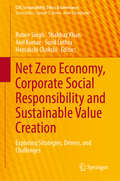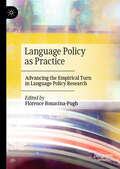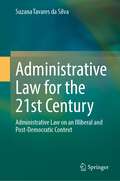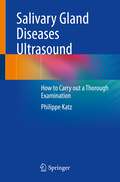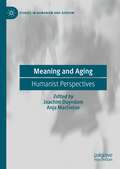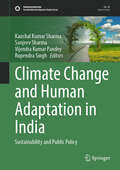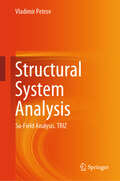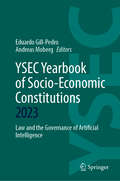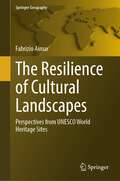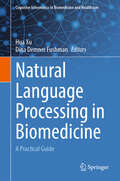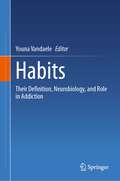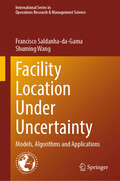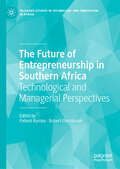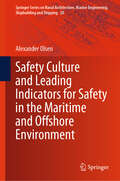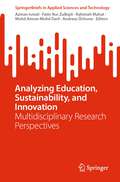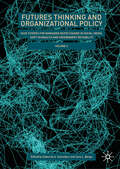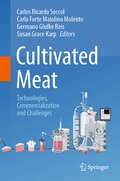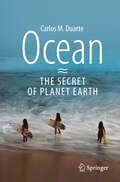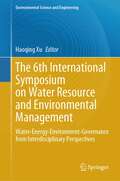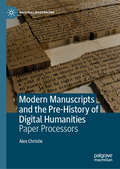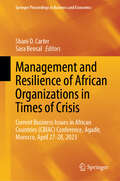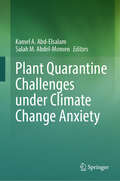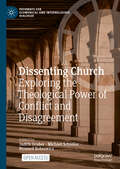- Table View
- List View
Net Zero Economy, Corporate Social Responsibility and Sustainable Value Creation: Exploring Strategies, Drivers, and Challenges (CSR, Sustainability, Ethics & Governance)
by Shahbaz Khan Anil Kumar Sunil Luthra Rubee Singh Hemakshi ChokshiThis edited volume brings together contributions from multiple experts in academia to explore the practical implications of the Net Zero Economy for corporate social responsibility and sustainable value creation in today's world. As the world approaches net-zero emissions by 2050, it is crucial for businesses to take corporate social responsibility seriously and make credible attempts to achieve sustainable value creation while reducing their greenhouse gas emissions. The book provides a comprehensive guide to navigating the complexities of corporate responsibility in the net-zero economy, drawing on the expertise of scholars in sustainable supply chain, environmental sciences, management, sustainable business management, and social sciences. With contributions from multiple experts, it examines the challenges that businesses face in reducing their climate impact and highlights the green growth opportunities that they can take advantage of in the net-zero transition. This edited volume is an essential read for students, research scholars, and industrial professionals working in sustainable development, eco-friendly business management, and corporate social responsibility.
Language Policy as Practice: Advancing the Empirical Turn in Language Policy Research
by Florence Bonacina-PughThis edited book brings together original contributions from scholars working across Language Policy and Planning to advance the recent 'Empirical turn' that has taken place in the field. All the chapters in the volume show how Language Policy can be conceptualized 'as practice' in a variety of domains, ranging from the home to the workplace, schools, and higher education. The authors also suggest further theoretical, methodological, and empirical developments for the discipline in light of this epistemological shift. A Foreword and an Afterword shed light on the theoretical and empirical lineage of this volume and show how this book contributes to the humanization of Language Policy research. This book will be of interest to scholars and post-graduate students working across Language Policy and Planning, Language in Education Policy, and Family Language Policy, as well as those in adjacent fields including Education Policy, Classroom Discourse, Linguistic Anthropology, Sociologyof Education, and Multilingualism.
Administrative Law for the 21st Century: Administrative Law on an Illiberal and Post-Democratic Context
by Suzana Tavares da SilvaThe book provides a discursive reflection on the current challenges facing administrative law, based on a key idea: the defence of the liberal model of society.The author describes the content of her book as a turning point on the traditional standards of the rule of law and the way it impacts on the administrative state and administrative law. Considering the current use (and abuse) of emergency law by governments – based on economic crisis, environmental crisis, pandemic, and the economic situation caused by the Ukraine war – she devises a different balance or equilibrium on the usual separation of powers. Many reasons contribute to this turning point: i) the weaknesses of an open society easily swayed by social networks; ii) social “tribalism” replaces common good and general interest; iii) social tribalism leads to illiberal society, which causes illiberal democracies; iv) illiberal democracies lead to ungovernability which reinforces the role of the government, the emergency law, and some de facto measures.The author looks at many recent decisions from the ECJ and the ECHR and some constitutional and administrative courts, which extends the interest of this work to a wide range of professionals, from scholars to students, from judges to lawyers, filling the gap from an administrative law perspective of the current issues.
Salivary Gland Diseases Ultrasound: How to Carry out a Thorough Examination
by Philippe KatzThis book details how, over the last 25 years, ultrasound examination as become an indispensable means of diagnosing salivary pathology. It presents the new machines equipped with high-frequency probes which now allow a real approach to the pathology and give a macro-photography of the tumor. Doppler ultrasonography can identify vascularization on inflammatory and tumoral processes, and ultrasound elastography now gives new details and helps judge whether tumors are benign or malignant. This book is a step-by-step guide describing best practices, from handling the probe and placing it on the salivary gland to diagnostic imaging, from infection and chronic diseases to cysts and tumors. Aimed at radiologists, ENT specialists, and maxillofacial surgeons, this book points out how the most inexpensive examination can yield maximum detail if carried out thoroughly.
Meaning and Aging: Humanist Perspectives (Studies in Humanism and Atheism)
by Anja Machielse Joachim DuyndamThe main objective of this book is to add, from a humanist perspective, new interdisciplinary insights and research results to the current academic debate on aging. The collection aims to enhance and complement the predominantly biomedical and sociological debates and provide a more comprehensive and highly topical view on aging and old age. By purveying a meaning-in-life perspective to the current debate we want to enrich and to deepen the research on aging, thus aspiring to an ideal of meaningful aging. The starting point of this book is a humanistic meaning frame for addressing basic needs of a meaningful existence, such as having goals in life, a sense of self-worth, connectedness with others, moral justification, a certain degree of understanding (comprehensibility), direction and influence with a view to cohesion in life, and not in the least place: (living) pleasure or excitement. Taken together, the essays show that experiencing a meaningful life contributes to one’s mentalresilience, conceived as the ability to realize a humane individuality (autonomy) in thinking and acting in situations of adversity and vulnerability, particularly those faced by older people.
Climate Change and Human Adaptation in India: Sustainability and Public Policy (Sustainable Development Goals Series)
by Sanjeev Sharma Kaushal Kumar Sharma Vijendra Kumar Pandey Rupendra SinghThis contributed volume presents an attempt to understand climatic variability and induced risk to livelihood of communities and to offer insights on how catastrophic conditions and crises can be mitigated through public policy interventions. The case studies herein offer insights into different spheres and domains affected by climate change and present models of adaptation possibilities. The book is divided into three thematic sections. The first contains chapters that deal with assessing the effects of climate change. The second section offers perspectives on adaptation and governance, vulnerability in the context of sustainable livelihoods. The third and last section looks at Policy and Governance, with respect to climatic change adaptation and mitigations. The lessons contained in this volume are useful to a wide audience including research scholars, students, policymakers, and planners.
Structural System Analysis: Su-Field Analysis. TRIZ
by Vladimir PetrovThis book provides a comprehensive exploration of SU-Field Analysis, a groundbreaking framework that delves into the intricate realms of fields, substances, and interactions. It commences with an introduction to the fundamental concepts (Chapter 1), followed by an elucidation of the basic configurations (Chapter 2) and an in-depth examination of various SU-Field systems (Chapter 3). Within Chapter 3, the text delves into the SU-Field model for fields, types of SU-Field systems for measurement and detection, and various SU-Field models. Subsequently, the book delves into the critical subject of eliminating harmful interactions (Chapter 4), discussing trends, introducing innovative solutions like S3, and exploring the use of substances and fields to decelerate detrimental effects. In Chapter 5, the focus shifts to finding desired effects, while Chapter 6 unveils the Law of Increasing Degree of SU-Field, elucidating its general trends and the forcing of substances and fields. Further insights into this law are presented in Chapter 6.4. Additionally, the book touches upon SU-Field Analysis in the context of information systems (Chapter 7) and introduces a new SU-Field structure (Chapter 8). The latter includes discussions on general concepts, parametric analysis, patterns of control elements, energy and information control, knowledge development, and structural analysis of information processing systems. Throughout, the book offers readers a comprehensive and detailed understanding of SU-Field Analysis, making it an invaluable resource for those seeking to explore this groundbreaking field.
YSEC Yearbook of Socio-Economic Constitutions 2023: Law and the Governance of Artificial Intelligence (YSEC Yearbook of Socio-Economic Constitutions #2023)
by Eduardo Gill-Pedro Andreas MobergArtificial intelligence (AI) has the potential to radically transform our society. It may lead to a massive increase in the capabilities of humankind and allow us to address some of our most intractable challenges. It may also entail profound disruption to structures and processes that have sustained our society over centuries. These developments present a unique challenge to the socio-economic constitutional arrangements which govern our world at national, regional and international level. The deployment of increasingly powerful AI systems, able to function with increasing degree of autonomy, has led to concerns over loss of human control of important societal processes, over the disruption of existing economic, social and legal relationships, and over the empowerment of some societal actors at the expense of others, together with the entrenchment of situations of domination or discrimination. It has also made increasingly clear how tremendous the potential benefits, that these technologies may bring, are to those who successfully develop and deploy them. There is therefore great pressure on governments, international institutions, public authorities, civil society organisations, industry bodies and individual firms to introduce or adapt mechanisms and structures that will avoid the potentially negative outcomes of AI and achieve the positive ones. These mechanisms and structures, which have been given the umbrella term ‘AI governance’, cover a wide range of approaches, from individual firms introducing ethical principles which they volunteer to abide by, to the European Union legislating an AI Act, which will prohibit certain types of AI applications and impose binding obligations on AI developers and deployers. The fast pace of innovation in the development of AI technologies is mirrored by the fast pace of development of the emerging field of AI governance, where traditional legislation by public bodies is complemented with more innovative approaches, such ashybrid and adaptive governance, ethical alignment, governance by design and the creation of regulatory sandboxes. The chapter “AI and Sensitive Personal Data Under the Law Enforcement Directive: Between Operational Efficiency and Legal Necessity” is available open access under a Creative Commons Attribution 4.0 International License via link.springer.com.
The Resilience of Cultural Landscapes: Perspectives from UNESCO World Heritage Sites (Springer Geography)
by Fabrizio AimarThis book explores the possibility of building the resilience of the UNESCO cultural landscapes, both using theoretical conceptions and practical strategies and actions. Two case studies have been selected, one in Italy and one in China, which have then been explored for the first time in such a comparative way. Different notions of landscape, as well as the driving force of changes affecting these landscapes, are examined and compared. Moreover, the perceptions of the local communities regarding these landscapes are examined, using online questionnaires with over 400 participants. This research highlights the need for an integrated management system, building stronger rural communities able to manage change and continuity. Five pillars to build the resilience of these landscapes have been provided, with schemes and figures, requiring a people-centered approach in their management. This book demonstrates strong connections between identity and landscape resilience, especially in inlandareas where the sense of identity is most prominent. Furthermore, it is structured to make it possible to replicate this investigation in ordinary case studies, i.e. ordinary landscapes. Scholars and professionals interested in cultural landscapes and heritage conservation are target of this book, as well as site managers.
Natural Language Processing in Biomedicine: A Practical Guide (Cognitive Informatics in Biomedicine and Healthcare)
by Hua Xu Dina Demner FushmanThis textbook covers broad topics within the application of natural language processing (NLP) in biomedicine, and provides in-depth review of the NLP solutions that reveal information embedded in biomedical text. The need for biomedical NLP research and development has grown rapidly in the past two decades as an important field in cognitive informatics. Natural Language Processing in Biomedicine: A Practical Guide introduces the history of the biomedical NLP field and takes the reader through the basic aspects of NLP including different levels of linguistic information and widely used machine learning and deep learning algorithms. The book details common biomedical NLP tasks, such as named entity recognition, concept normalization, relation extraction, text classification, information retrieval, and question answering. The book illustrates the tasks with real-life use cases and introduces real-world datasets, novel machine learning and deep learning algorithms, and large language models. Relevant resources for corpora and medical terminologies are also introduced. The final chapters are devoted to discussing applications of biomedical NLP in healthcare and life sciences. This textbook therefore represents essential reading for students in biomedical informatics programs, as well as for professionals who are conducting research or building biomedical NLP systems.
Carpal Instability: The Comprehensive Case-Based Approach
by Jeffrey YaoThis case-based guide is the most comprehensive, up-to-date work focusing on the topic of carpal instability. This work presents all aspects of the conditions including anatomy, physical examination, classification, kinematics, and nonsurgical and surgical methods of management. A wide variety of topics are presented, such as dynamic, static acute, and chronic reducible scapholunate ligament injury, subacute lunotriquetral ligament injury, perilunate injury, SLAC wrist, and more. For each topic, the traditional options as well as the most cutting-edge treatment modalities are discussed in detail, illustrated with numerous clinical and intraoperative photos. Written by a world-class international group of authors comprised of the most widely known experts in the field of carpal instability from around the world, this practical guide will serve as the authoritative resource for young and senior surgeons alike.
Habits: Their Definition, Neurobiology, and Role in Addiction
by Youna VandaeleThis book explores the multiple facets of habit from diverse and complementary theoretical frameworks. It provides a complete overview of the cognitive, computational, and neural processes underlying the formation of distinct forms of habit. The objective of the book is to cover (1) the multiple definitions of the habit construct and the relation between different habit-related concepts, (2) the underlying brain circuits of habits, and (3) the possible involvement of habits in psychiatric disorders such as alcohol and substance use disorder. This book will be of interest to all researchers in behavioral and computational neuroscience, psychology, and psychiatry who are interested in associative learning and decision making, under normal and pathological conditions.
Facility Location Under Uncertainty: Models, Algorithms and Applications (International Series in Operations Research & Management Science #356)
by Shuming Wang Francisco Saldanha-da-GamaThis textbook provides researchers, post-graduate students, and practitioners with a systematic framework for coping with uncertainty when making facility location decisions. In addition to in-depth coverage of models and solution techniques, application areas are discussed. The book guides readers through the field, showing how to successfully analyze new problems and handle new applications. Initially, the focus is on base models and concepts. Then, gradually, more comprehensive models and more involved solution algorithms are discussed. Throughout the book, two perspectives are intertwined: the paradigm for capturing uncertainty, and the facility location problem at hand. The former includes stochastic programming, robust optimization, chance-constrained programming, and distributional robust optimization; the latter includes classical facility location problems and those arising in many real-world applications such as hub location, location routing, andlocation inventory.
The Future of Entrepreneurship in Southern Africa: Technological and Managerial Perspectives (Palgrave Studies in Technology and Innovation in Africa)
by Robert Ebo Hinson Patient RambeThis edited collection examines the impact of new technologies and new managerial and policy perspectives on entrepreneurial development in Southern Africa, paying particular attention to small and medium sized enterprises, which contribute significantly to GDP and employment, but often find it difficult to survive beyond the first five years. Chapters are divided in two parts, the first covering technological perspectives and the second managerial perspectives. Africa’s cultural and geographic diversity is taken into account, with authors from Ghana, Lesotho, South Africa and Zimbabwe providing regional case studies and the editors synthesising these discussions in a concluding chapter that touches on sustainability and development to working lives and livelihoods across the region. Exploring critical issues of entrepreneurial human capital development, innovation, technology, legislative frameworks and marketing strategies, this book will be of great interest to researchers, students and policymakers.
Safety Culture and Leading Indicators for Safety in the Maritime and Offshore Environment (Springer Series on Naval Architecture, Marine Engineering, Shipbuilding and Shipping #20)
by Alexander OlsenThis book provides guidance and insight into the development process for safety indicators to comply with general classification rule requirements. The utilisation of this guidance will provide tangible benefits as the marine and offshore industry is able to realise the positive results of tangible safety indicators that are developed correctly and managed appropriately throughout the lifecycle of the vessel or platform. In the marine and offshore industry, design and equipment configurations vary from one system to the next, and systems are in many cases increasingly complex. There are gaps in codes and standards which may lag technological innovations and there are issues related to interfaces between systems. Safety indictors such as risk analyses, FMEA, job safety analyses, management of change procedures, HSQE, technical manuals and reliability-based maintenance provide a formalised approach to identify hazardous situations, address the gaps and interconnection variances, and improve safety, environmental performance and operational downtime. The majority of Classification Societies (‘Class’) require their clients to develop and submit safety indicators as part of the classification requirements for certain systems and to obtain certain special notations.
Analyzing Education, Sustainability, and Innovation: Multidisciplinary Research Perspectives (SpringerBriefs in Applied Sciences and Technology)
by Andreas Öchsner Azman Ismail Mohd Amran Mohd Daril Fatin Nur Zulkipli Rahimah MahatThis book describes a diverse array of studies unravelling the intricate interplay of education, sustainability, and organizational dynamics. From innovative teaching methodologies to sustainability trends and the pandemic's impact, this compendium offers a rich tapestry of insights. This book traverses through a compendium of studies that intricately dissect the synergy between education, sustainability, and organizational dynamics. This book is ideal for academics, practitioners, and curious minds seeking a deeper understanding of these vital contemporary forces.
Futures Thinking and Organizational Policy, Volume 2: Case Studies for Managing Rapid Change in Social Media, Shift in Wealth and Government Instability
by Zane L. Berge Deborah A. SchreiberThe case studies in this Volume 2 book support the premise that organizational policies are what ensure institutionalization and sustainability of futures thinking in corporations, non-profits, and educational institutions. Futures thinking here reflects a systems approach utilized by organizational leaders to observe and interpret signals of change or disruption, identify trigger points of impact, employ foresight methodologies to build scenarios of the future and plan action, and then ultimately translate/actualize the most viable scenarios into successful business outcomes. What is new in the field of futures thinking today is not the general source of change (i.e., technology, globalization, and workforce well-being), but the tumultuous level of disruption occurring due to three phenomena—explosive use of social media, shift in great wealth, and government instability. Scholars and practitioners alike will find the case studies in this book provide nuanced insights into such disruptions, as well as discussion of best practices to ensure successful business solutions.
Cultivated Meat: Technologies, Commercialization and Challenges
by Carlos Ricardo Soccol Carla Forte Maiolino Molento Germano Glufke Reis Susan Grace KarpCultivated meat is an emerging substitute for conventional meat that is not associated with animal farming and slaughtering. Instead, animal cells are cultivated in bioreactors and post-processed into “artificial” meat products. Although this new technology solves several ethical and environmental problems, there are techno-economic challenges that need to be addressed to make the commercial-scale production of cultivated meat a real perspective. This book addresses fundamental aspects of new food systems, animal cell culture and cultivated meat production, including cell lines, culture media, microcarriers and scaffolds, bioreactors, downstream processes, formulation, packaging, quality control, scale-up, and waste management. Also, aspects related to commercialization, market, patents, legislation, global and regional policies, and sustainability metrics such as life-cycle assessment, together with a bioeconomy perspective analysis, are reviewed. Finally, case studies are presented and the challenges and future prospects for cultivated meat production are proposed. This book is a collection of 21 chapters written by specialists in the field.
Ocean - The Secret of Planet Earth
by Carlos M. DuarteThe ocean characterises planet Earth and differentiates it from the more than 5000 known planets. It is also the habitat where life emerged as a singularity in the universe. However, we know less about the oceans than we do about some remote planets such as Mars.This book provides basic facts for understanding the oceans, their properties and their importance to mankind through the ages. The long relationship between the ocean and humanity, which permeates all areas of our culture, is at a crossroads where human activity is profoundly affecting its functioning and the integrity of marine ecosystems. However, the intelligent and rational use of the ocean holds, in large part, the key to providing the resources needed to sustain our quality of life in the future. Unlocking, through scientific research, the secrets that the ocean still holds is an essential challenge for humanity. This book informs the reader about all these aspects of the ocean through a text that combines scientific rigour with personal reflections based on the author's own experiences, dedicated to exploring and learning more about the ocean.
The 6th International Symposium on Water Resource and Environmental Management: Water-Energy-Environment-Governance from Interdisciplinary Perspectives (Environmental Science and Engineering)
by Haoqing XuThis book is designed to be the introductory work in the Water-Energy-Environment-Governance from Interdisciplinary Perspectives Series and provides an in-depth look at sustainable development and management in the water sector across. The water-energy-environment nexus (WEEN) represents important interstate connections of water, energy, and the environment. Present day water and energy systems are interdependent. Water is used in all phases of energy production and electricity generation. Energy is required to extract, convey, and deliver water of appropriate quality for diverse human uses and then again to treat waste waters prior to their return to the environment. Security in water, energy, and the environment is associated with human, economic, and environmental sustainability. This interweaving is strengthening under aggregating natural resource scarcity and climate change. This book includes selected papers from the 6th International Symposium on Water Resource and EnvironmentalManagement (WREM 2023) and consists of themes pertaining to water resource and environmental management. It provides readers with comprehensive information, and formulation of solutions leading to a set of Water-Energy-Environment-Governance from Interdisciplinary Perspectives through our forum and the publication of your research. As a reference, it is of interest to students, scientists, engineers, government officials, and water resource managers.
Modern Manuscripts and the Pre-History of Digital Humanities: Paper Processors (Material Modernisms)
by Alex ChristieWhile text processing is often associated with the digital humanities, it is still seen as worlds apart from literary modernism and its aesthetic preoccupations. This book upsets that narrative. Examining literary manuscripts from some of the twentieth century's best-known and lesser-known novelists, from Marcel Proust to Mina Loy, Alex Christie reveals where authors experimented with proto-digital writing methods by hand. Instead of looking to computers as sources of inspiration, the authors discussed turned to twentieth-century media for their ability to reveal new layers of the material world. From analog fantasies of contacting the dead to digital anxieties of invisible information, the aesthetic ambitions of these novels can be traced back to their author's interest in emerging media devices and their technical operation. To capture the magic of such devices through writing, these authors devised radical methods for generating literary text, anticipating today's digital humanities.
Management and Resilience of African Organizations in Times of Crisis: Current Business Issues in African Countries (CBIAC) Conference, Agadir, Morocco, April 27-28, 2023 (Springer Proceedings in Business and Economics)
by Shani D. Carter Sara BensalBusinesses in African countries continued to face crises due to COVID-19, supply chain, and climate change. Governments can take steps to increase businesses’ resilience by supporting and promoting sustainable development. In turn, businesses can increase their resilience by promoting the resilience of their employees. This book explores the current state of management and resilience in African nations and discusses issues that revolve around its reciprocal impact on global business, government, and society. Featuring select papers from the 4th Annual Current Business Issue in African Countries (CBIAC) Conference held in Agadir, Morocco in 2023, this book focuses on the synergies between climate change, supply chain and sustainable development, particularly post pandemic featuring content from business and NGO leaders, faculty, and students. The impetus of the CBIAC conference was the discussions held at the United Nations Conference on Trade and Development (UNCTAD) held in Nairobi, Keyna in July 2016 and in Bridgetown, Barbados, and Geneva in October. The goal of the conference is to create long-term collaborative relationships between business leaders, faculty, researchers, students, and community members from different African nations.
Plant Quarantine Challenges under Climate Change Anxiety
by Kamel A. Abd-Elsalam Salah M. Abdel-MomenThe effects of climate change on food safety and plant health represent a relatively new area of study. However, evidence from recent studies is clear: climate change contributes to increased and new food safety & plant health risks as one of several global change factors. This volume analyzes the scientific understanding of the relationship between climate change, food safety, plant pests, plant diseases, and trade. It identifies and discusses four key areas for future policy consideration: risk assessment, SPS capacity in developing countries, climate change resilience, and basic research challenges. We must effectively communicate the impacts of climate change on plant health and build the capacity of national plant protection organizations. More importantly, we need to mobilize resources that will help build stronger national phytosanitary systems that can prevent the spread of plant pests, thereby protecting our food sources and environment, and facilitating safe trade.The present volume is an asset for plant quarantine personnel working in the field, agricultural university students, plant health workers, farmers doing agriculture, plant & seed traders, and all those who use agricultural produce and products. The book is a useful resource for students and professional plant pathologists, entomologists, and plant breeders because it summarizes current knowledge and suggests new research directions. It is also suitable for ecologists & researchers working on crop protection, climate change, and pest control.
Dissenting Church: Exploring the Theological Power of Conflict and Disagreement (Pathways for Ecumenical and Interreligious Dialogue)
by Michael Schüßler Judith Gruber Ryszard BobrowiczThis book challenges the prevailing notion of stability, cohesiveness, and uniformity within Christian communities, inviting readers to view contestation and disagreement as integral to theological reflection and church identity. While the volume focuses predominantly on the Roman Catholic Church as a case study, various chapters broaden the exploration across other Christian and non-Christian traditions. Beginning with the philosophical and theological foundations of conflict, contestation, and community, the book subsequently focuses on four main conflict fields: liturgy, canon law, gender, and sexuality, as well as race and postcolonial critical theory. The book finishes with a constructive proposal on how to think theologically about identity and antagonisms, as well as how to construct an ecclesiology of dissent. Contributors employ diverse methodological perspectives to offer constructive theological reflections, enhancing both understanding and practice of theology in the context of polarised public debates.This is an open access book.
Bodies, Ontology, and Bioarchaeology: Articulating 14th Century Life at Arroyo Hondo Pueblo (Bioarchaeology and Social Theory)
by Ann M. PalkovichThis volume introduces the place of Arroyo Hondo Pueblo in our understanding of Southwestern Archaeology in the Northern Rio Grande. The author discusses the reanalysis of the skeletal and mortuary remains that draws on a half century of research since the original excavations were conducted by the School of American Research from 1970-1974 under the direction of Douglas W. Schwartz. The volume offers a close read of the mortuary evidence at Arroyo Hondo Pueblo and integrates ideas about corn as a central feature of Tewa cosmology with this crop as the paramount dietary staple. The author discusses the health consequences of dry-farming subsistence and present evidence for malnutrition and other dietary issues and finally describes the impact of malnutrition and other maladies on the everyday lives of Arroyo Hondo’s villagers. This volume is for readers interested in bioarchaeology, paleopathology, and Southwestern Archaeology.
